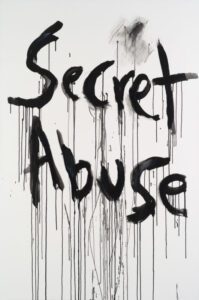
My wife and I are driving down Yonge Street on a midsummer’s trip to Toronto in our almond colored, Honda Civic hatchback (our first vehicle) with the windows rolled down blasting out Kool Thing on our cassette deck as we meander to our campsite on the edge of town. The blood surging through my veins, super hyped, I am on top of the world, no cares, just this overwhelming feeling of euphoria, power, and strength. Music has the uncanny ability to instantly teleport a person back to a particular moment to relive that experience as if re-watching a favorite film. When I think of Kim Gordon my mind goes straight to Sonic Youth.
It is unfair to expect this type of nirvana with Kim Gordon’s new project but to make comparisons is unavoidable. Having seen “Exposed: Songs for Unseen Warhol Films” at the Carnegie Music Hall coming in, I knew the drill. Unlike traditional music videos, where the music comes first, then the visual is made to fit the music; in this case the visual comes first. The band is essentially being asked to write a score for the film Kiss, selected from the Warhol archives. As one would expect from a Warhol film, it features long static shots, in this case, yep, you guessed it 14 couples (female, female; male, male; female, male) making out, clocking in at just under an hour. The film is about desire but without the ultimate payoff in the end. Instead, we just get an extended foreplay. It is not erotic; it is so obviously acted that it lacks sensuality. It is the epitome of camp. Gordon and her pals, collaborators: Bill Nace, Steve Gunn, and John Truscinski create a long slow dirge which provides a parallel counterpart to the lack of fulfillment that comes with the visual. It’s as if you are standing still on a moving walkway at an airport being whisked along to the proper gate but when you finally arrive ultimately your plane is grounded. No highs, no lows, it just chugs along.
Obviously there was a palpable buzz about seeing Kim Gordon perform live on the opening night of the exhibition, which by the way takes place at the Warhol Museum in Pittsburgh, PA and is entitled Lo-Fi Glamour. Ultimately, this initial excitement waned and could not be sustained for an entire hour. The piece functions much more successfully in the confines of the gallery setting on the 2nd floor. Within this enclosed space two synchronized projections of the film face each other and the live recording that the band made in May in the Warhol Theater accompanies the films. You would be hard pressed to find someone to willingly endure the 54-minute film in its entirety. In this setting the viewer has options. Since there really isn’t any true beginning or end, the audience gets to choose how to engage with the piece and for how long. In smaller doses it is much more palatable. Also, the volume is set at a much more humane level, which leads me to the most disheartening aspects of the live performance – THE VOLUME. I wore earplugs and I was still getting bombarded, my head hurt because it was so freaking loud. It was torturous.
As to the rest of the exhibition, it is arranged somewhat chronologically and has small groupings of work from various time periods. They are like mini-shows within the larger show. Featured prominently are text paintings. These gestural acrylic paintings with drips feature either black painted text on white or gold painted text on white. Band names make up the text for the black on white paintings: Pussy Galore, Dude Wars, Hair Police, to name a few. For the gold on white hash tag paintings, Gordon appropriated phrases from Twitter during the 2016 presidential election and the Women’s March: #This is Illegal, #Pussy Grabs Back, and also #Male White Corporate Oppression, a line from the Sonic Youth song mentioned earlier, Kool Thing. It’s intriguing to see these slogans in analog format. It’s as if she is asking rhetorically, what really is the impact of these social protests and the frenzy of social media itself? It speaks to the commodification of protest. It also creates an ironic bridge to Warhol and his encapsulation of commercialism, consumerism and commodity because these handmade slogans are now showing up in a high art venue. Again, blurring the distinction between hi and lo art and perhaps providing evidence of Gordon waxing nostalgic about her pre-digital past and calling up references to the handmade, DIY aesthetic and also a nod to the title of the exhibition.The most engaging works of the exhibition were the figure drawings/paintings. Of course, Gordon could frame them within a feminist lens and they were part of her Airbnb series, so she was obviously making some commentary about packaging and commodification here as well. But they were so loose and self-assured and less self-conscious than most of the other work and were not solely dependent on the underlying concept. There was an immediacy to them, much like her work with Sonic Youth, where you just had this powerful, visceral experience. This happened to some extent within the text paintings as well but once you read the text, it literally turned into a one-liner.

inches, Courtesy of the artist and 303 Gallery, New York
Kim Gordon first and foremost is a musician. That is where she cemented her legacy. In its heyday Sonic Youth was every bit as influential as the Velvet Underground. The mantra of rock: buy a guitar, learn three chords, and start a band. This egalitarian ethos is at its core. Gordon invested most of her adult life into developing her music. In this her first solo museum exhibition she attempts to bring this punk mentality into her visual art. For the record, music wins.
Scott Turri
Volume 34 no 1 September – October 2019

